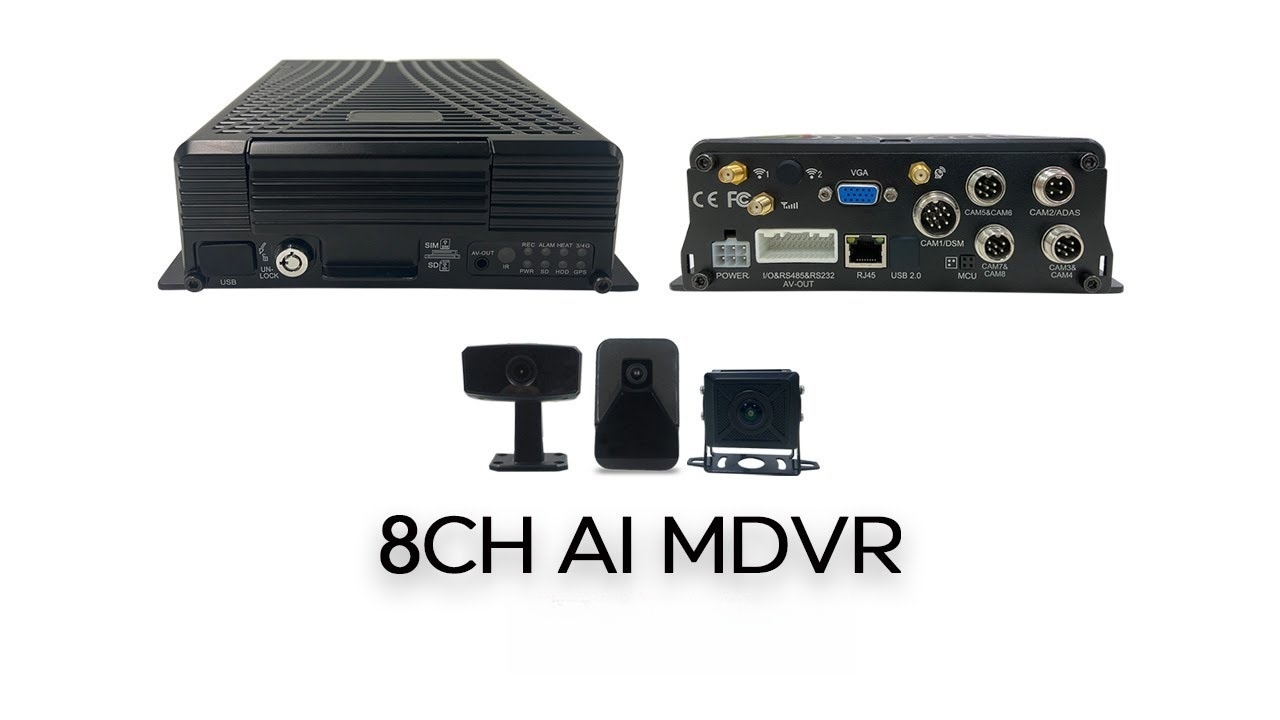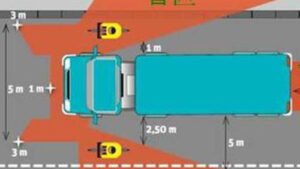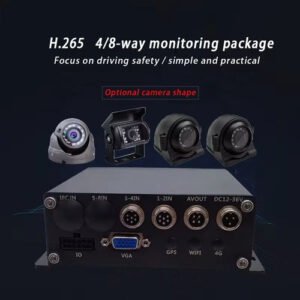Introduction to MDVR Technology
Mobile Digital Video Recorder (MDVR) technology has emerged as an essential component in the logistics and transportation sectors, providing a robust solution for improving visibility, safety, and operational efficiency. MDVRs are sophisticated devices designed to capture, store, and manage video footage from various sources, such as cameras mounted on vehicles. This functionality allows companies to monitor their fleet’s activities in real-time, thereby enhancing accountability and responsiveness during operations.
A key feature of MDVR technology is its multi-channel recording capability, which enables users to connect multiple cameras simultaneously. This ensures comprehensive coverage of the vehicle’s surroundings, including blind spots that traditional monitoring systems might neglect. The recorded footage is invaluable for analyzing driving behavior, resolving disputes, and ensuring compliance with industry regulations. Furthermore, advanced MDVR systems often integrate GPS functionality, enabling precise tracking of vehicle locations, speeds, and routes, which aids in streamlining logistics operations.
The significance of MDVRs extends beyond mere surveillance; they also serve as powerful data management tools. With built-in storage solutions and cloud integration options, MDVRs offer capabilities for data retrieval and analysis, facilitating improved decision-making processes. This technology is particularly vital in reducing operational costs, as it allows fleet managers to identify inefficiencies and implement corrective actions promptly. Moreover, by providing visibility into driver performance and vehicle conditions, MDVRs contribute significantly toward enhancing safety standards across the transportation network.
In summary, the role of MDVR technology in logistics and transportation is pivotal. Its ability to ensure comprehensive visibility through advanced video recording and data management capabilities not only aids in enhancing safety but also streamlines overall operations, making it an indispensable asset in modern transportation management.
Understanding the 8CH Analog HD Feature
The 8-channel (8CH) feature of the MDVR (Mobile Digital Video Recorder) represents a significant advancement in logistics and transportation management by providing extensive monitoring capabilities. With the ability to connect and record from eight cameras simultaneously, this technology enables comprehensive visibility across various points of interest in a moving vehicle or fixed location. The incorporation of multiple channels enhances not only the quality of monitoring but also the flexibility in camera placement and coverage.
One of the primary benefits of the 8CH system is its capacity for real-time observation. Operators can monitor activities in and around the transport vehicle continuously, which is crucial for ensuring the safety of both the cargo and the drivers. For instance, a logistics vehicle could be equipped with cameras that cover the driver’s area, cargo space, and multiple exterior angles, providing a complete view of the operational environment. This multimodal coverage allows for proactive risk management, as any unusual activity can be recorded and addressed immediately.
Moreover, the ability to record from multiple cameras simultaneously ensures that no critical event goes unnoticed, which is particularly valuable in transportation where conditions can change rapidly. By offering high-definition recording across eight channels, the MDVR allows for meticulous incident documentation that can be analyzed later for improving security protocols and operational efficiency. In addition, having access to multiple viewpoints aids in resolving disputes, enhancing accountability, and promoting transparency among stakeholders in the supply chain process.
Overall, the 8CH Analog HD feature significantly elevates the monitoring capabilities that logistics and transportation companies can leverage. By ensuring comprehensive coverage through simultaneous recordings, businesses can improve their operational oversight, leading to safer and more efficient management practices.
Benefits of Comprehensive Visibility in Logistics
In the realm of logistics and transportation management, the necessity for comprehensive visibility cannot be overstated. It plays a pivotal role in facilitating efficient operations and ensuring that companies can respond swiftly to any issues that may arise. By integrating advanced Mobile Digital Video Recorders (MDVRs), organizations can foster a more transparent and accountable environment. This technology empowers stakeholders to track shipments and vehicle usage in real-time, leading to informed decision-making which minimizes operational disruptions.
One key benefit of enhanced visibility is the significantly improved safety of logistics operations. With MDVRs, fleet managers can monitor driver behavior, such as adherence to speed limits and compliance with safety regulations. This not only helps in reducing accident rates but also aids in fostering a culture of safety amongst drivers. Studies have indicated that fleets utilizing monitoring technologies can experience a drop in incident rates by up to 30%, thus ensuring the well-being of both the drivers and the goods being transported.
The reduction of theft is another significant advantage of comprehensive visibility within the logistics sphere. According to statistical reports, companies that have effectively implemented tracking systems can reduce cargo theft incidents by 20% or more. With real-time monitoring capabilities provided by MDVRs, any suspicious activity can be detected early, enabling prompt action to safeguard assets. Not only does this protect inventory, but it also enhances customer trust as deliveries are more secure.
Furthermore, accountability is markedly improved through the implementation of MDVR technology. The ability to review footage allows companies to identify process efficiencies and inaccuracies, thus refining logistics performance. This transparency instills confidence in clients as they can be assured of the integrity of the logistics process. In essence, comprehensive visibility, powered by MDVRs, is foundational to achieving operational excellence in logistics and transportation management.
Integrating MDVR with Transportation Management Systems (TMS)
Integrating Mobile Digital Video Recorders (MDVR) with Transportation Management Systems (TMS) represents a significant advancement in logistics and transportation management. By merging these two technologies, companies can achieve enhanced operational visibility, improved data collection, and streamlined decision-making processes. The integration can be approached through various technological frameworks and platforms, depending on the existing infrastructure of the TMS.
The process begins with identifying the requisite data points captured by the MDVR, such as video footage, GPS coordinates, and vehicle diagnostics. These data streams can then be synchronized with the TMS software to provide real-time updates on fleet activities. For instance, the integration can harness data from the MDVR to automatically update delivery statuses, monitor vehicle conditions, and enhance route optimization. This capability not only mitigates delays but also enhances customer satisfaction through timely communications.
Furthermore, the harmonization of the MDVR with TMS facilitates the aggregation of data from multiple sources, including driver behavior, vehicle performance, and traffic patterns. This comprehensive data acquisition enables companies to gain actionable insights, leading to informed decision-making. For example, integrating these data sets can help identify inefficiencies in routing or highlight patterns of driver performance that may require training interventions. Additionally, access to real-time footage can aid in the rapid assessment of accidents or incidents, ensuring quick responses and efficient resource allocation.
The value of a unified system cannot be overstated, as it centralizes operations and allows for greater analytical capabilities. TMS and MDVR integration ultimately empowers logistics and transportation organizations by providing a more holistic view of their operations. This level of integration not only improves service delivery but also bolsters the overall safety and efficiency of transportation management practices.
Real-Time Monitoring and Alerts
The integration of 8CH Analog HD Mobile Digital Video Recorders (MDVRs) in logistics and transportation management significantly enhances operational oversight through real-time monitoring capabilities. These advanced systems facilitate continuous surveillance of logistics operations, providing opportunities for timely intervention in case of any anomalies. The availability of live video feeds and GPS tracking enables fleet managers to maintain oversight of their assets, ensuring operational efficiency and safety.
MDVRs are designed to alert users whenever unusual events occur, thereby minimizing potential risks. Configurable alerts can be set up to notify fleet operators about critical incidents such as harsh braking, sudden acceleration, or geofence violations. These alerts can be transmitted via mobile applications or integrated with existing monitoring systems, allowing for immediate information exchange. Such prompt notification mechanisms empower logistics professionals to respond rapidly to any irregularities, mitigating the effects of disruptive occurrences effectively.
Moreover, the ability to analyze data collected from the MDVRs fosters decisive action when necessary. For instance, consistent monitoring can reveal patterns of unsafe driving behavior, enabling the implementation of training programs for drivers to improve overall safety. In addition, the retention of recorded video footage plays a crucial role in post-incident analysis, providing valuable insights that can inform future operational strategies.
Enhanced visibility delivered by MDVRs not only supports compliance with safety regulations but also cultivates trust among stakeholders by demonstrating a commitment to maintaining high standards of operation. The implementation of effective real-time monitoring and alert systems is therefore indispensable for transportation companies aiming to optimize their logistics processes while ensuring the safety and security of their assets.
Compliance and Regulatory Considerations
The implementation of 8CH Analog HD Mobile Digital Video Recorders (MDVR) in logistics and transportation management must be approached with a clear understanding of the compliance and regulatory frameworks that govern video surveillance and data usage. Companies leveraging MDVR technology are obligated to navigate various legal requirements to maintain lawful operations while optimizing their logistics systems.
First and foremost, it is essential to consider the privacy laws applicable in the jurisdictions where operations occur. Many regions have specific regulations regarding the collection, storage, and processing of video footage, particularly in public spaces. Regulations such as the General Data Protection Regulation (GDPR) in Europe and the California Consumer Privacy Act (CCPA) in the United States impose strict guidelines on how companies must handle personally identifiable information. Businesses must ensure that their MDVR systems are compliant by implementing robust data protection measures and informing employees and customers about surveillance practices.
Additionally, there are industry-specific regulations that may impact the use of MDVRs. For instance, companies involved in the transportation of hazardous materials may be subject to regulations from the Department of Transportation or similar entities, which may include stipulations on the monitoring of transport vehicles. Compliance with these regulations not only enhances operational efficiency but also ensures the safety and security of goods during transit.
Furthermore, organizations should be aware of the requirements for data retention and access. Many regulations dictate how long surveillance data can be stored and who has access to it. Establishing a clear data management policy is crucial to meet these requirements while leveraging the benefits of MDVR technologies for logistics optimization.
In adhering to these compliance and regulatory considerations, companies can confidently deploy 8CH Analog HD MDVR systems, ensuring they enhance operational visibility without compromising legal and ethical standards.
Challenges and Solutions in Implementation
Implementing an 8CH Analog HD Mobile Digital Video Recorder (MDVR) system within logistics and transportation management can present several challenges. One of the primary concerns is connectivity. As logistics operations often take place across diverse locations with varying network conditions, maintaining a reliable connection to transmit video data can be problematic. To mitigate this issue, selecting a solution that supports multiple communication options, such as 4G LTE and Wi-Fi, can ensure seamless data transfer even in low-signal areas.
Data storage is another significant hurdle when deploying MDVR systems. High-resolution video footage takes up considerable storage space, raising concerns regarding retention time and archiving. Opting for a system with expandable storage options, such as external hard drives or cloud integration, can effectively address these concerns. By implementing a structured storage policy that prioritizes critical footage, organizations can efficiently manage video data without overwhelming their systems.
Another challenge faced during implementation is user training. Employees may struggle with operating advanced technology like MDVR systems, preventing them from fully utilizing its capabilities. Comprehensive training programs should be developed, ensuring that users are familiar with the system’s functionalities. By utilizing visual aids, hands-on training sessions, and ongoing support, organizations can build user proficiency, maximizing the benefits of the MDVR system.
Lastly, there is the question of costs associated with implementing an MDVR system. Although the initial investment may be substantial, the long-term benefits often outweigh these expenses. Organizations are encouraged to conduct a cost-benefit analysis to illustrate potential savings from improved operational efficiency and safety. Additionally, exploring financing options or seeking grants can alleviate financial burden, making implementation more feasible.
Future Trends in MDVR Technology
The landscape of Mobile Digital Video Recorders (MDVR) is evolving rapidly, particularly within the logistics and transportation sectors. As technology progresses, several key trends are expected to dominate the future of MDVR systems, enhancing their functionality and utility. One significant trend is the integration of artificial intelligence (AI). The incorporation of AI algorithms into MDVR systems allows for advanced features such as real-time video analysis, driver behavior monitoring, and incident detection. These AI-driven enhancements not only improve safety but also optimize operational efficiency by reducing the chances of accidents and facilitating timely interventions.
Another prominent trend is the shift towards higher-definition video capabilities. As the demand for clearer and more detailed images increases, future MDVR systems are likely to adopt 4K or even higher resolution video recording. This advancement will provide logistic companies with superior visibility, enabling them to capture critical information in intricate detail, such as license plates or street signs, crucial for accurate reporting and incident investigation.
Moreover, advancements in data analytics are poised to significantly impact the logistics and transportation management landscape. As MDVR systems collect vast amounts of data, the integration of sophisticated analytics tools will enable organizations to derive actionable insights. Predictive analytics can forecast potential issues, assess route efficiency, and enhance decision-making processes. These insights not only streamline operations but also facilitate proactive maintenance of vehicles, ultimately leading to reduced downtime and cost savings.
In the coming years, these trends—AI integration, higher-definition video capabilities, and enhanced data analytics—will redefine MDVR technology, making it an indispensable tool for logistics and transportation firms aiming to achieve comprehensive visibility and operational excellence.
Conclusion
In today’s ever-evolving landscape of logistics and transportation management, investing in Mobile Digital Video Recorders (MDVR) such as the 8CH Analog HD MDVR is paramount. These advanced solutions serve as crucial tools that enhance visibility, significantly improve operational efficiency, and ultimately provide a competitive edge. By integrating MDVR technology, companies can achieve a holistic view of their transportation processes, ensuring that every moment is accounted for and managed effectively.
The deployment of MDVR systems facilitates real-time monitoring of fleet operations, thereby empowering businesses to respond swiftly to potential disruptions. This responsiveness not only minimizes delays but also optimizes resource allocation, leading to cost savings. Furthermore, the data collected by MDVR solutions can foster informed decision-making; when businesses gain insights into their operations, they can identify areas for improvement and streamline processes accordingly.
Moreover, the safety and security of goods in transit are enhanced through MDVR technologies. By offering high-definition video footage and comprehensive reporting, these systems help in safeguarding assets against theft or damages. The undeniable value of such capabilities cannot be overlooked, as they contribute to building a trustworthy brand reputation in a competitive market.
MDVR systems are not merely a technological upgrade; they represent a strategic investment in the future of logistics and transportation. As stakeholders in this sector actively seek to embrace innovative solutions, the integration of MDVR will likely emerge as a differentiating factor, leading to improved operational standards and enhanced customer satisfaction. Emphasizing the necessity of such investments, it becomes clear that MDVR solutions are not just an option; they are essential for sustainable growth and success in logistics and transportation management.






